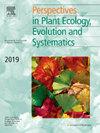Together but not mixed: mistletoe genetic diversity and seed disperser activity between evergreen and deciduous forests
IF 2.9
3区 环境科学与生态学
Q1 ECOLOGY
Perspectives in Plant Ecology Evolution and Systematics
Pub Date : 2025-02-12
DOI:10.1016/j.ppees.2025.125850
引用次数: 0
Abstract
Habitat structure plays an important role in determining forest mammals' abundance and activity patterns, impacting their interactions with plant species. In the southern South American temperate rainforests, two mistletoe species (Tristerix corymbosus and Desmaria mutabilis) depend on the arboreal marsupial Dromiciops bozinovici for seed dispersal, inhabiting a mosaic of evergreen and deciduous Nothofagus-Araucaria forests. We used camera traps to compare marsupial abundance, visitation rates, and daily activity patterns between evergreen and deciduous forests. Also, we sequenced DNA (using SNPs) from both mistletoes to assess their genetic diversity, population genetic structure, and landscape genetics. Dromiciops bozinovici visited T. corymbosus more frequently in the evergreen forest and D. mutabilis in the deciduous forest, as it is the only mistletoe species found above 1250 m of elevation. Both mistletoe species showed similar genetic diversity between forest types, but T. corymbosus was more diverse than D. mutabilis; population structure was weak but significant in both cases. In both cases, gene flow was stronger towards the evergreen forest, and this asymmetry was more pronounced for D. mutabilis. Also, geographic and genetic distances were positively correlated except for D. mutabilis in the deciduous forest. Dromiciops bozinovici activity and abundance varied according to forest type and mistletoe species associated, which seem to be influencing gene flow and genetic diversity patterns. Interaction between plants and frugivores is particularly relevant in high-mountain forests, where mistletoes provide major resources for frugivores, which shape their spatial and genetic structures.
在一起而不是混合:常绿和落叶森林之间的槲寄生遗传多样性和种子传播活动
生境结构对森林哺乳动物的丰度和活动模式起着重要的决定作用,影响着它们与植物物种的相互作用。在南美洲南部的温带雨林中,两种槲寄生物种(Tristerix corymbosus和Desmaria mutabilis)依赖于树栖有袋类动物Dromiciops bozinovici进行种子传播,它们栖息在常绿和落叶的Nothofagus-Araucaria森林中。我们使用相机陷阱来比较常绿森林和落叶森林之间有袋动物的丰度、访问率和日常活动模式。此外,我们还对两种槲寄生的DNA进行了测序(使用snp),以评估它们的遗传多样性、群体遗传结构和景观遗传学。在海拔1250 m以上,bozinovici是唯一的寄生物种,常绿林中,bozinovici的寄生频率更高,落叶林中,mutabilis的寄生频率更高。两种槲寄生在不同林型间表现出相似的遗传多样性,但冠状槲寄生的遗传多样性高于变异槲寄生;两种情况下的种群结构都很弱,但都很显著。在这两种情况下,常绿森林的基因流更强,这种不对称在突变霉中更为明显。除落叶林中的变异曲霉外,地理距离与遗传距离均呈正相关。不同的森林类型和寄生物种不同,bozinovici活性和丰度也不同,这似乎影响着基因流动和遗传多样性模式。植物与食果动物之间的相互作用在高山森林中尤为重要,槲寄生为食果动物提供了主要资源,塑造了它们的空间和遗传结构。
本文章由计算机程序翻译,如有差异,请以英文原文为准。
求助全文
约1分钟内获得全文
求助全文
来源期刊
CiteScore
6.50
自引率
0.00%
发文量
28
审稿时长
67 days
期刊介绍:
Perspectives in Plant Ecology, Evolution and Systematics (PPEES) publishes outstanding and thought-provoking articles of general interest to an international readership in the fields of plant ecology, evolution and systematics. Of particular interest are longer, in-depth articles that provide a broad understanding of key topics in the field. There are six issues per year.
The following types of article will be considered:
Full length reviews
Essay reviews
Longer research articles
Meta-analyses
Foundational methodological or empirical papers from large consortia or long-term ecological research sites (LTER).

 求助内容:
求助内容: 应助结果提醒方式:
应助结果提醒方式:


